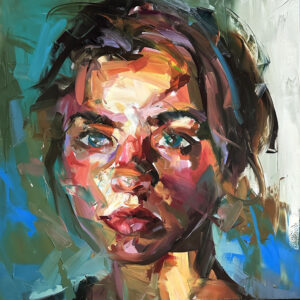
Sasha Gordon, 24, is the self-portraitist taking the art world by storm. She paints big, massively intricate, technically brilliant pictures of herself; many as different characters: sometimes looming closeups of her face, sometimes group scenes, sometimes voluptuous nudes, all in a style that brings to mind the Chinese Cynical Realists of the 1990s. She had her first solo show in the summer of 2021 with Los Angeles gallerist Matthew Brown, who first came to visit her in Somers, Westchester County, when she was still a student at Rhode Island School of Design, and her work was hung throughout her Polish-Jewish-American father and Korean mother’s home. A year after the LA show, she’s a fast-rising star of figurative painting.
Gordon’s artworks begin with selfies and found images and continue with feeling. When she was growing up, the artist had trouble expressing her emotions, she says. Now she paints doppelgängers of herself with many different expressions and bathes her face in otherworldly colors and gradients, and more recently abstract patterns too. “I’m interested in ways of expressing internal emotions and feelings, not just by facial expressions and body language,” she explains. “I think the different textures and patterns of their ‘skin’ can convey the sensitivity of their bodies." It’s a new approach to expressionist painting that comes from finding ways to express her emotions but also her identity: as a young, queer, Asian American woman growing up in a relatively small town, she never quite fit in, and over the years her artworks have explored her obsessive-compulsive disorder, her discomfort with her body, her complicated feelings about her own identity, and her journey through life.
Gordon is part of the new wave of figurative painters exploring identity in all of its depth and complexity. Self-portraiture has helped her better understand who she really is. It’s helped her to feel more permanent and present. “In the past, dissociating and experiencing depersonalization was a way for me to avoid confrontation with myself,” she says, “I was in a sort of denial about my identity. Creating these worlds with my characters has given me a sense of autonomy. Painting these versions of myself is the ultimate confrontation: I see myself clearly.”










 in your life?
in your life?

